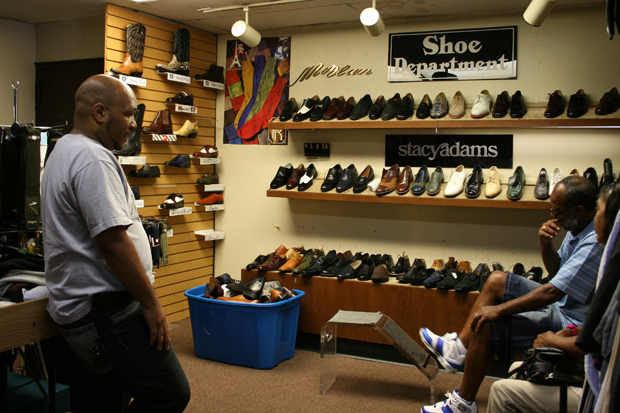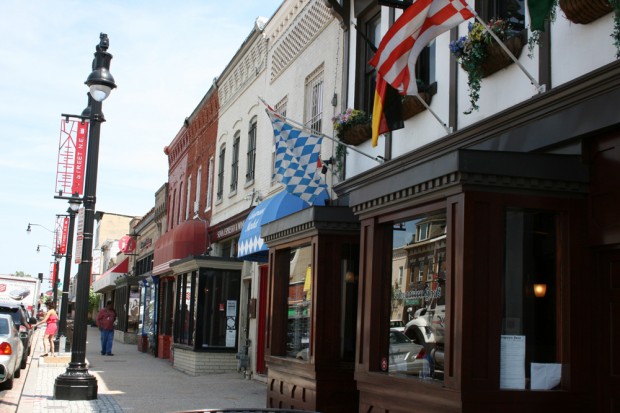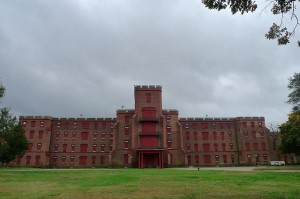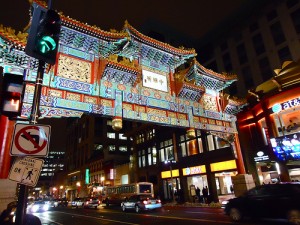Elahe Izadi / DCentric permalink
A sign on the front of George's Place reminds passersby how long it's been on the corridor.
A sign on the front of George's Place reminds passersby how long it's been on the corridor.
An employee sorts through items at George's Place. Owner George Butler says he's known for his selection of hats.
George Butler speaks with longtime customers about his impending closure.

A customer tries on shoes, hoping to take advantage of George's Place's going out of business sale.
George Butler is closing shop after nearly five decades. His men’s clothing store, George’s Place Ltd., is an H Street NE institution, one of the longest-running businesses on a corridor now synonymous with gentrification. But the recession, online competition and H Street streetcar construction led him to call it quits.
The 73-year-old managed clothing stores on the street in the 1950s before opening his store in 1968.
“I saw a future in H Street and my being in the neighborhood, I knew a lot of my customers,” he said while sitting in the back of his store on a recent afternoon. Hats and shoes lined the walls, along with 50 percent off signs.
Through it all, he’s had a front row seat to all the ups and downs of the corridor: from the heyday when it was “it was like Connecticut Avenue, like downtown,” to the 1968 riots. “I’m a vet, and I saw things I never saw in the war,” he recalled of the riots. “The street was unreal. Fires were everywhere. It was just burning down.”
The riots marked the commercial decline of the street, beginning decades of empty storefronts. “People left and never came back,” Butler said.
Michelle Jones, owner of A.S.P.I.R.E. health store at 7th and H streets NE.

A number of new businesses have populated formerly vacant storefronts along the upper end of H Street. But they're mostly restaurants and bars.
Much has been made of the changes along H Street NE as the corridor continues its transformation from a primarily low and middle income black community to one that is wealthier and whiter. Trendy bars and restaurants are increasingly opening in vacant storefronts, attracting diverse patrons en masse during late night hours. But the crowds are nowhere to be seen during the day.
A new D.C. grant program is intended to draw more retail options to the street, creating an H Street that’s as bustling during the day as during the evening. That’s welcome news for many existing business owners who want more people on the streets and in their shops.
“You just don’t want it to be all bars and restaurants,” said Anna Collins, co-owner of pet store Metro Mutts at 5th and H streets.
Continue reading

John / Flickr
The west campus of St. Elizabeths in Southeast D.C. will be the site of the new U.S. Coast Guard headquarters.
Neighborhoods east of the Anacostia River are undergoing changes, albeit they aren’t taking place as rapidly as west of the river.
Higher-income folks slowly moving into east of the river communities, which are primarily low-income, are contributing to those changes. But massive development projects will likely have more of an immediate, and major, impact on the area.
Much of that development will take awhile; the transformation of St. Elizabeths Campus into the new U.S. Coast Guard headquarters likely won’t be complete until after 2016. But other projects, meant to piggy-back off of the St. Elizabeths project, may come to the neighborhood before then. The Washington Post reports that plans are being finalized for the $25 million redevelopment of 2235 Shannon Place SE from a police evidence warehouse into a mixed-use office building:
The office project is the first step in a long-term, transformational overhaul of downtown Anacostia being planned by a partnership between District-based Curtis Properties — which owns large chunks of land there — and Four Points, a D.C. developer that is making its name on projects in emerging neighborhoods.
Such projects will bring many daytime office workers east of the river, people who want options for lunch and who may want to relocate to nearby neighborhoods to be close to work. Some are already bracing for the changes. The District’s Department of Transportation has plans to expand D.C. Circulator to roll past St. Elizabeths Campus in the next few years.
The word “gentrification” elicits certain images, particularly in D.C: dog parks, coffee shops and bike lanes. But the mere presence of such things doesn’t mean residents are being displaced.
The Washington Post tried to also dispel another stereotypical marker of gentrification – white people — by profiling a group of middle and upper income African Americans who have moved into (or back) to Anacostia:
“I used to think it was about race — when white people moved into a black neighborhood,” said lawyer Charles Wilson, 35, president of the Historic Anacostia Block Association. (Wilson ran against Marion S. Barry Jr. in the 2008 Ward 8 City Council race.) “Then, I looked up the word. It’s when a middle-class person moves into a poor neighborhood, and I realized, I am a gentrifier. I couldn’t believe it. I don’t like that word. It makes so many people uncomfortable. The g-word.”
“Actually, I thought it was if you see a white guy in Anacostia, listening to an iPod, jogging or walking a dog!” joked Sariane Leigh, putting her hand on her hip and waving a sweet potato fry for emphasis. Leigh, 33, works by day helping low-income communities access education. In her free time, she writes a blog called “Anacostia Yogi,” and teaches “Soul Flow Yoga” at the Hillcrest Recreation Center on Denver Avenue in Southeast.
These residents chose Anacostia over other neighborhoods because they like living east of the river, and many longtime residents say they are happy to see professional blacks moving into black neighborhoods, the Post reports. Those profiled are active in the community, such as Courtney Davis who published a children’s books meant to bolster the image of kids in Ward 8. “I’m fighting for this neighborhood,” Davis told the Post. “It still has some work to do. But I’m not here to make a quick buck and run off.”
But are these new, wealthier residents making it too expensive for low-income residents to remain in the neighborhood? Typically, gentrification is thought of not just when people with more money move into a working class neighborhood; it’s also when that movement raises housing prices and prices out low-income residents. And by-and-large, displacement isn’t occurring in communities east of the Anacostia River, according to Roderick Harrison, a Howard University professor and senior fellow at the Joint Center.
“Probably the more appropriate term is ‘succession,’” he said. “People have been moving out of wards 7 and 8 because once you can afford to do so, you do. People feel they’re improving their lives with moves to Prince George’s County.”
Pamela Johnson, who owns a storefront in the H Street NE neighborhood, says her property value has gone up so much that she can’t afford to pay her tax bill. Her story is included in The New York Times gentrification piece, which caused Matthew Yglesias to ask if property owners can ever be the victims of gentrification:
Normally you think of the gentrification problem as applying to renters. Objective conditions improve in a poor neighborhood, which is good. But the improved conditions lead to higher rents, so the poor people wind up not benefiting since they have to move out. It’s difficult for me to see how this kind of problem could afflict property owners, who regardless of race or class considerations ought to benefit from asset appreciation.
But as Ta-Nehisi Coates of The Atlantic points out, winning out financially isn’t always the only priority for owners:
I actually think it’s fairly easy to understand Johnson’s beef. She likes her neighborhood as it is. She may well be able to “sell high,” but the fact is she doesn’t want to sell at all. She probably would love to see her property values rise, but the neighborhood isn’t simply, for her, a financial instrument–it’s an emotional one. In that sense, Johnson isn’t very different than millions of other humans who invest in neighborhoods.
Her contention that the city is “driving us out of here.” is very much debatable. But it’s worth noting that a class of owners with a commitment to something more than a naked financial return is a good thing. When Matt asserts that the city is trying to make H Street a “desirable place to live,” I am compelled to ask “desirable for whom?” I’m not being obtuse here–I understand, in the aggregate, his larger point. But very often people find a kind of value in their living condition that eludes socioeconomic data.
And although individual owners may make money by selling properties in increasingly pricey areas, what kind of overall effect do such sales have on neighborhoods? In Logan Circle, for instance, a group of low to moderate-income homeowners are contemplating selling their modest town homes to a developer for $800,000 each. If they decide to sell, they could walk away with a large return. But if they sell and leave the neighborhood, they take with them much of Logan’s remaining income diversity.
The Grey Lady published a feature about gentrification around H Street NE and how the city is losing its black majority:
The shift is passing without much debate, but it is leaving ripples of resentment in neighborhoods across the city, pitting some of the city’s long-term residents, often African-American, against affluent newcomers, most of whom are white, over issues as mundane as church parking and chicken wings.
The story makes mention of the defeat of Adrian M. Fenty in the 2010 mayoral race and how some focused on used dog parks and bike lanes as symbols for affluent whites “re-arrang[ing] spending priorities to suit themselves.” Adam Serwer of The American Prospect argues the disparity in unemployment rates was the issue in the election; for whites, unemployment increased by 1 percent, while it increased by 5 percent for African Americans and doubled for Latinos:
What happened during Fenty’s term was that black people and Hispanic people lost their jobs while white people largely kept theirs. Blaming this on Fenty is unfair, but given that politicians are always evaluated in part by the jobs they help create (or lose) voting him out was an entirely rational decision. I’m not sure why, in a story about Washington DC’s internal racial divisions, the only mention of this is a throwaway line about unemployment in Ward 8. Alongside the city’s black exodus, the uneven impact of the economic crisis is the story.
The story touched off a Twitter debate among locals about the city’s changing face and how the media and the public talks about gentrification:
A high-rise may be built on the parking lot of an affordable senior apartment building in the U Street neighborhood.
Jair Lynch Development Partners is proposing to build a nine-story, 95 unit building next door to the Paul Laurence Dunbar Apartments at 15th and V Streets NW. Last year, the developers partnered with residents to buy the senior building. As part of the developer’s current proposal, the senior building would get some upgrades but maintain its Section 8 senior housing status. Residents reportedly support the project, which still has a few more approvals to get before it can break ground.
The new building may be much more expensive than the Dunbar apartments as it doesn’t have the same U.S. Department of Housing and Urban Development requirements attached to it. Although it’s unclear at this point how much the units would go for, this is the same developer behind Solea Condominium just up the road. Units in that building were selling for around $600,000 when it opened in 2008.
The site of the senior building has a storied history — it was once home to the Dunbar Hotel, built in the early 1900s and the District’s premier hotel for elite African Americans. The affordable senior apartment building was built on the land in the 1970s, and it’s remained Section 8 even as the surrounding neighborhood saw housing prices skyrocket. A look at the proposed new building, sandwiched between the Dunbar apartments and St. Augustine Catholic Church, the oldest Catholic black church in the District, shows the same stark contrast between new and old buildings seen throughout D.C.
Jair Lynch Project
D.C. is a city full of tours, from riding around on Segways to learning about ghosts. But it’s also a city divided over issues of race and class — and whether what’s happening is gentrification or revitalization — so why not have some tours on that, too?
Enter ONE DC “Shaw Gentrification & Resistance Tour,” which takes place at 6:30 p.m., Wednesday. Participants will walk around Shaw and learn about the neighborhood’s history. They will also hear the organization’s perspective on D.C.’s changes: that development has negatively impacted longtime residents. The self-described progressive group aims to address the “structural causes of poverty and injustice” with a “deep analysis of race, power, and the economic, political, and social forces at work in Shaw and the District.” Anyone wanting to participate in the tour is asked to contribute $10, with the proceeds going to the Asian/Pacific-Islander Domestic Violence Resource Project.
This isn’t the first such tour on gentrification in D.C. Does anyone know of a revitalization tour focused on the flip side?

jessstah / Flickr
The Friendship Archway is next to the commercial space with what may be the city's most expensive rent.
The storefront with the highest retail rent isn’t in Georgetown or Dupont Circle — it’s in Chinatown.
That’s according to DCMud, which reports that the only vacancy on the corner of 7th and H Streets NW is going for $250 to $300. That’s a lot. Georgetown businesses typically pay $100 to $120 per square foot, and Union Station, which currently has the city’s highest rates, leases space for about $200 per square foot, DCMud reports.
Although many of Chinatown’s most visible businesses are national chains, the neighborhood still has a number of small, family-owned restaurants, harkening back to a time when Chinatown still had a sizable immigrant Chinese population. But given the increase in retail rates in the neighborhood, those longing for a resurgence of mom-and-pops joints may want to look elsewhere.
Corner of 7th and H Streets NW.
During the 1960s, about 23,000 residents were displaced from Southwest to make room for urban renewal. Old, decaying housing was demolished to make way for new apartments for middle and upper income families, with some public housing units included.
Five years later, researchers asked: what happened to those thousands of poor residents who left? Sociology In My Neighborhood points us to the study, which focused in on 98 families who, unlike the majority of those who were evicted, did receive help relocating. These 98 families reported, five years after they left Southwest, living in housing physically better than where they used to live, but:
For those interviewed, poverty continued… and they then suffered “from another set of problems created by their removal from what was once their homes” because they lost not only their homes but also “a functioning social system.” Some became sick with grief, like that experienced by a death in the family, which was a common reaction to such relocations. Seventy percent of those interviewed had visited SW after redevelopment, and “a significant number..talked about crying and feeling sick” when they visited.
The redevelopment of the 1950s and 1960s was very different than what’s occurring in D.C. today — there is no leveling of entire neighborhoods, which may have contributed to the scale of trauma felt by people displaced by urban renewal decades ago. But D.C. is in flux. Market forces are causing rents and housing prices to increase, and some of those who can’t afford to live here anymore are leaving. Do they feel the same, or differently, as displaced residents felt decades ago?
The NPR Argo Network is a collection of websites by NPR member stations committed to strengthening local journalism
Learn More...
Humanosphere reports on global health and the fight against poverty from KPLU in Seattle
The Empire Reports on city and state politics from WNYC in New York
The Informant reports on cops, courts and communities from KALW in Oakland
Multi-American reports on immigration and cultural fusion from KPCC in Southern California
On Campus reports on higher education from MPR in Minnesota
Ecotrope reports on nature and community from OPB in Oregon
The Key reports on local music from WXPN in Philadelphia
CommonHealth reports on health, medicine and healthcare reform from WBUR in Boston
Argo MindShift reports on technology and education from KQED in San Francisco
Home Post reports on the military from KPBS in San Diego